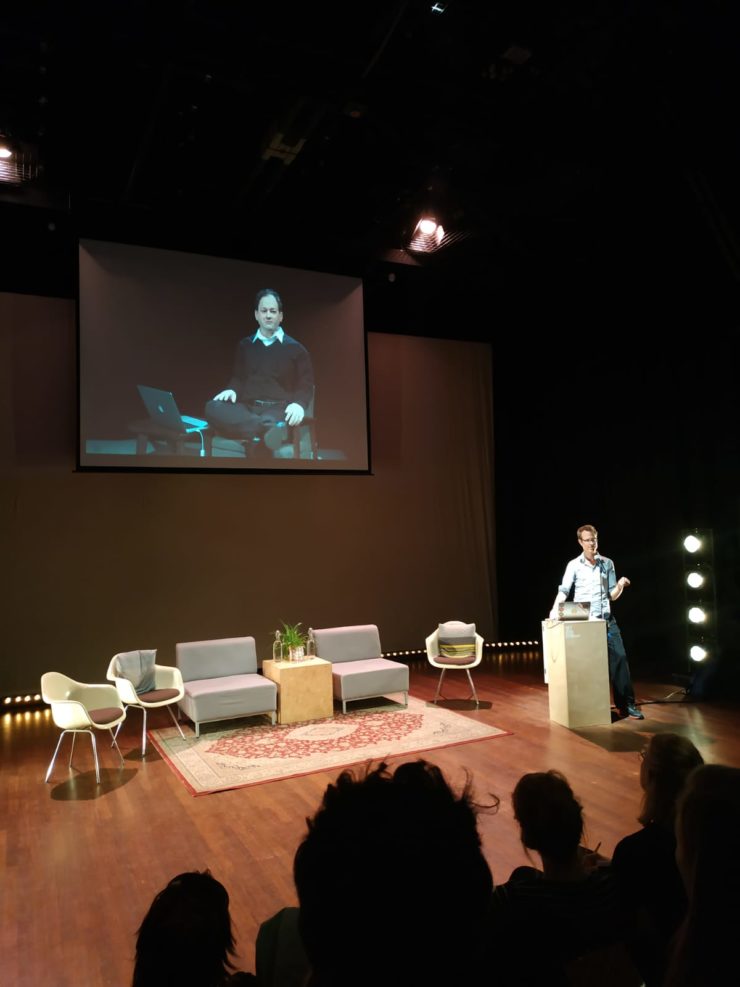Blog Posts
Performing Robots Conference: Walking Through an Uncanny Valley
Jose Hopkins B
The Uncanny Valley is a concept coined by Masahiro Mori and borrowed by theatre director Stephan Kaegi[i] to make a homonymic performance. This concept is used to explain the dip in human’s affinity and affective pairing in relation to a replica’s human likeness. The valley’s dip is produced when an apparently human-like replica, for example a prosthetic hand, is experienced as not real. “We could be startled during a handshake by its limp boneless grip together with its texture and coldness. When this happens, we lose our sense of affinity, and the hand becomes uncanny.”[ii]
Kaegi’s performance situates Mori’s thoughts on current issues of human-object, human-human relationship and functionality. What does a “human replica” is and what it (or he) it is supposed to do? A performing machine is on stage presenting the nuances of Mori’s concept, using the record of casting a replica from and of his own body as exemplification. He (or it) self-identifies as Thomas Melle, a German writer, and through retelling Melle’s memories, a brief analysis on Alan Turing’s life and the Turing effect, it becomes a he (or perhaps he always was a he). Melle is much the performer as it (or he) is Melle. The performer is Melle’s replica, a casted image, but the separation between them is blurry, even inexistent. As “programmed”, “directed” and “dramaturged” as an actor’s performance, the machine is not an object nor a subject. It is the materialization of the inevitability of the anthropos in the post-human. Both Melles are a representation and represented, both are extensions of the other, both are the same. A theatre light also performs in the same way as Melle, but different; the same way as the audience, but different. Fixed but apparently organic, constrained but apparently free, dead but apparently alive. We are walking through the uncanny valley and Melle is Kharon, guiding us through this landscape where all is neither dead nor alive.

Stefan Kaegi on his show Uncanny Valley, photo by Irene Alcubilla Troughton
Echoing with Michelangelo’s David, Melle is also a sculpture proposing new cannons. On one hand, Melle’s body (position and proportions) suggests a transformation of a perfectly balanced body. Now sitting down, the main focus still lies on a resting position post or prior a movement. But the physicality of the movement is beyond the limits of the “traditional” body, as its limits are no longer the same. On the other hand, Melle is a new canonical beauty and standards of bodily perfection. The same way the David was a depiction and materialization of human image’s perfection, the moving machine, the performing robot invites us to rethink and understand what makes us human. Are we still aiming for god-like figures? Or our god-like figures’ shape has changed?
What do ‘similarities’ mean then, when we are building a thing, a robot, a replica or ourselves? What elements of ourselves are we abstracting in order to extrapolate them into things? Is this the uncanny valley? The timelessness of the image that we are? As a sort of post-mortem picture, the existence of Melle as a machine is also based on functionality. But its ‘function’ is a different type of functionality, perhaps it is a non-functional functionality; a function outside factory environments. Its existence is shaped by the ambivalence between horror and empathy; affinity and uncanny. Its reflexive presence invites us to see ourselves in and with his David-like proportions, through the memories that it is retelling using projected photos on a screen. A story that is the representation of a picture of a memory whose ownership is still unclear. Do we remember the same way? Do we remember a moment or the representation of that moment? How much of what we define as ours is actually mediated and maintained by the uncanny? The Uncanny Valley is then a performance that is not restrictive to Thomas Melle’s lecture. The limitlessness between these two versions of the same confronts us with our own limitlessness existence. We perform the same way it is performing.
Notes
[i] Kaegi, Stefan and Rimini Protocol. Uncanny Valley Performed by Thomas Melle Spring Festival, Kikker Theater, Utrecht, 23 May 2019
[ii] Mori, Masahiro. “The Uncanny Valley.” IEEE Robotics & Automation Magazine, 1970/2012: 98-100.

